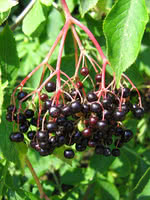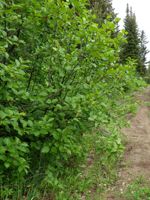Mon-Fri 9am - 5pm Mountain time
Black Elderberry vs Sitka Alder
Sambucus canadensis
Alnus alnobetula subsp. sinuata
NOT AVAILABLE THIS SEASON - MIGHT RETURN
CUSTOM GROW
Black Elderberry is a deciduous shrub native to eastern North America. You can plant this shrub in moist areas and it will help stabilize your soil. You can also use it on rural properties anywhere you'd use a lilac.
Black Elderberries are considered to be partially self-pollinating. So while they will still produce some berries without cross-pollination, planting with another variety will increase yields. Consider planting with Ranch Elderberry or Bob Gordon Elderberry.
Warning: the seeds, stems, leaves, roots, and uncooked berries of the Black Elderberry are poisonous to humans when eaten in quantity. You should cook the berries to make them safe for human consumption.
Sitka Alder is a native deciduous shrub or small tree that often forms dense thickets. Its extensive root system stabilizes slopes and streambanks. Nitrogen-fixing capabilities and nutrient-rich leaf litter improve soil fertility, creating better growing conditions for surrounding plants. These qualities make it especially effective in disturbed or erosion-prone sites.
Often found in moist, high-elevation mountain environments, Sitka Alder also enhances habitat by providing cover and structure in both riparian and upland areas. Birds and small mammals utilize it for nesting, and its seeds serve as a food source.
Note: We use Sitka Alder for Alnus alnobetula subsp. sinuata. This species is also known by many other common names, including Mountain Alder, Green Alder, and others. Please confirm the scientific name to ensure you are ordering the correct plant.
Black Elderberry Quick Facts
Sitka Alder Quick Facts
Toxicity: leaves, stems, and uncooked berries are poisonous to humans

